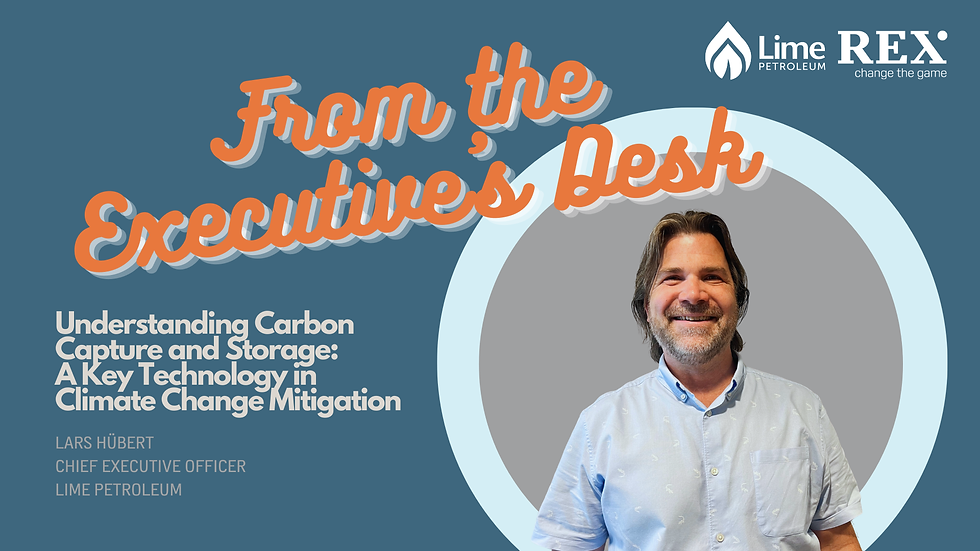Understanding Carbon Capture and Storage: A Key Technology in Climate Change Mitigation
- Rex Content

- Aug 31, 2024
- 3 min read

Rex's subsidiary Lime Petroleum (Lime) recently announced that, together with partners OMV Norge AS and Vår Energi ASA, it has been awarded a carbon dioxide (CO2) storage licence in the North Sea by the Norwegian Ministry of Energy. The Iroko carbon storage licence, situated in the North Sea approximately 130 kilometres west of Haugesund, will be operated by Vår Energi.
Obtaining this carbon storage licence is a significant milestone for Rex and Lime in our journey to enhance our green efforts. Join us as we explore Carbon Capture and Storage (CCS) and uncover the transformative potential of this essential technology in our efforts to counter climate change.
What is CCS?
CCS is a pivotal technology in global efforts to combat climate change by capturing carbon dioxide emissions from hard-to-abate industrial processes and power generation, and permanently storing them in geological formations. This innovative process involves three main steps: 1) capturing CO2 emissions, 2) transporting them to suitable storage sites, and 3) securely storing them deep underground. The Iroko project will focus on the third step, providing secure storage in the North Sea.
Capture Process
The CCS process begins with capturing CO2 emissions at their source, such as from industrial facilities like power plants, steel mills, cement factories, and other large-scale emitters. Various technologies are employed depending on the source, to ensure effective separation of CO2 from other gases produced during combustion or industrial processes.
Transportation
Once the CO2 gets captured, it undergoes compression and gets converted into a dense, transportable fluid. This compressed CO2 is then transported via pipelines, ships, or road transport to designated storage sites. Transportation methods vary based on geographical factors and the volume of CO2.
Storage
The final step involves injecting the CO2 deep underground into geological formations that are capable of securely storing it for long periods. These storage sites typically include saline aquifers, depleted oil and gas reservoirs, un-mineable coal seams, basalt formations, and organic-rich shales. These geological formations provide natural barriers, ensuring that the CO2 remains contained and does not migrate back to the surface. The Iroko carbon storage licence in which Lime holds a 30 per cent interest, is capable of storing up to 7.5 million tonnes of CO2 annually for a minimum of 30 years, totalling approximately 215 million tonnes.
Benefits of CCS
CCS offers significant benefits in the fight against global warming as greenhouse effects and climate change resulting from the entry of CO2 into the atmosphere is prevented. The United
Nations Intergovernmental Panel on Climate Change (IPCC) stated in its 2023 report that CCS is crucial in achieving the goals set out in the Paris Agreement by helping to limit global temperature increases to safe levels.
Safety and Viability
CCS has a proven track record of safety and viability, with commercial-scale operations dating back more than four decades. Technologies involved in CCS, including capture, transport and storage, are well-established and continuously improved through ongoing research and development efforts globally.
Current Implementations and Developments
There are approximately 395 large-scale CCS facilities globally, marking a significant increase from previous years. These facilities are distributed across regions such as the Americas, Europe, the Asia-Pacific and the Middle East, with notable concentrations in the United States and the United Kingdom. The collective CO2 capture capacity of these facilities continues to expand, in line with the growing momentum and investment in CCS technologies worldwide.
CCS represents a critical pathway towards achieving sustainable and decarbonised industries, playing a vital role in the transition to a low-carbon future. With ongoing advancements and increasing deployment, CCS continues to demonstrate its potential as a key climate mitigation solution on a global scale.




